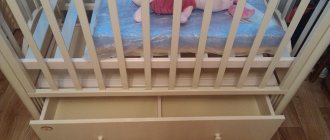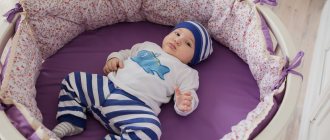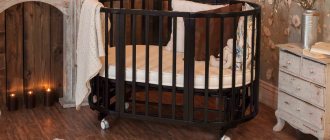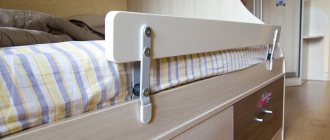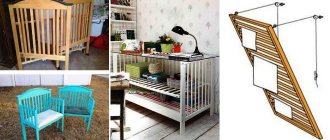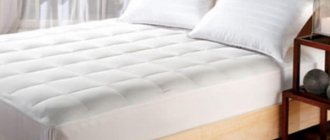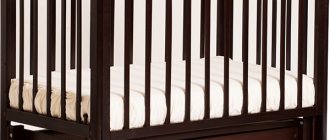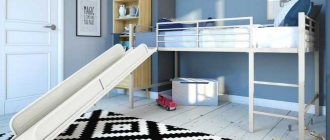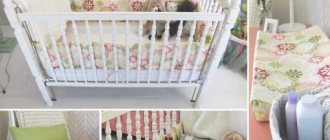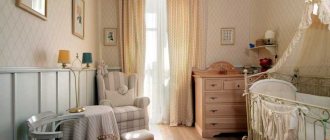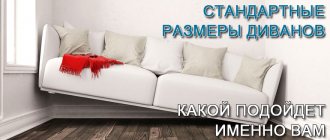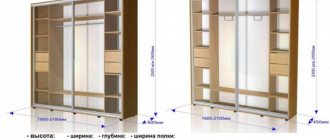When buying a children's bed, one of the main criteria is the dimensions of the furniture. Selecting the right model in size and height will provide your child with the comfort and safety that is important to him.
When planning to buy furniture for a child’s sleep, you need to pay attention to such parameters as the height of the children’s bed, its length and width. The variety of models presented in the store will make it easy to choose an option with suitable dimensions for the correct arrangement of a full-fledged sleeping place, depending on age.
Basic criteria for choosing children's beds
Convenience and safety are the most important parameters by which any children's furniture is selected. The crib is selected in accordance with the height and age of the baby, which allows you not to clutter the room with a product “for growth”, replacing it as needed. Baby sleeping furniture is equipped with a protective grille that prevents accidental falls to the floor.
When a child grows up (he is already 5, 7 or 10 years old), his attention is attracted by non-standard designs of cribs in the form of a car, an airplane, a boat, like a princess from a cartoon. In this case, the choice depends not only on the gender of the children, but also on the compliance of the purchased furniture with current standards.
Security - what to consider
A safe product is one that cannot cause injury when interacting with it. The bed should not have gaps between the parts - a curious baby can stick a finger in there and painfully pinch it. Any roughness is also unacceptable - splinters are a very unpleasant thing for thin children's skin. All metal fasteners are masked with wooden or plastic plugs.
The distance between the rods of a baby crib is made no more than six cm. The sides are made removable and stationary. The bed should be quite stable - the narrower and higher the model, the more likely it is to tip over. Any sharp corners or various traumatic decorations are prohibited.
Material of manufacture
It is better to choose natural material from which the bed is made. The most popular are wooden products that are not treated with paint, varnish, or carefully sanded. This is especially important for young children - when the baby is teething, he chews everything, including the sides and bars of the bed. When purchasing, you need to request a hygiene certificate - the design should not have an unpleasant odor or any chemical impurities. When the crib is covered with paint, its composition must be fully described in the certificate - lead and other similar substances are unacceptable.
Models made from mixed materials - wood with MDF, fiberboard, chipboard are also often used, but you should clarify what class of materials are used. Wood in combination with metal and plastic are allowed, but they must be of very high quality. Such designs are painted in bright colors and have an unusual shape.
Best materials
One of the most important selection criteria is the materials used in the manufacture of the frame. To make a decision, you should consider the characteristics of the possible options:
- Metal – metal furniture looks very stylish. Less dust settles on it. An absolute plus is the high strength of the product. Disadvantages may include heavy weight. Manufacturers have learned to combat this by using high-tech alloys;
- Wood – teenage beds made of solid wood are perfect for those who plan to use them for a long time. Wooden furniture is more expensive than other analogues, but it is environmentally friendly, durable and presentable. A solid wood bed looks restrained and dignified.
- MDF - the main advantage of this option is its affordable price. Pressed wood is not as durable as natural wood, but products made in accordance with GOST will last at least 10 years;
- Plastic - furniture made of plastic is reliable, has an attractive appearance and is light in weight, it is pleasant to touch. Please note that it is easy to leave a scratch or stain on the plastic from caustic dye. Lovers of home creativity are recommended to choose models in dark shades.
MDF
Tree
Plastic
Metal
Mattress can be made from:
- Foam rubber - over time, dents form in places experiencing point loading. Not particularly suitable for teenage beds. Suitable as additional material for models with a soft headboard;
- Coconut fiber – used for hard mattresses. Environmentally friendly raw materials, well ventilated, which prevents the proliferation of harmful microorganisms and the appearance of unpleasant odors;
- Latex – characterized by high elasticity. It is durable and provides maximum comfort while sleeping. The disadvantage is the high price of the product (a mattress measuring 120x200 cm costs from 10 thousand rubles);
- Polyurethane foam - used in spring and springless mattresses. Has medium hardness. Lasts a long time. Due to the layered structure, it ensures a comfortable body position;
- Memoryform – from the name it is clear that the material has “memory”. It captures a person's position and maintains it for several seconds. The effect of plasticine is created. Sleeping on such a mattress relaxes and gives strength.
Teenagers are often taller than their parents. And muscle mass can be quite significant. Tall boys can weigh 90 kg. You should keep this in mind when choosing a mattress.
Recommended mattress firmness.
| Teen weight | |||
| Up to 50 kg | From 50 to 80 kg | From 80 to 100 kg | |
| Rigidity | Soft | Average | Hard |
Coconut
Memoryform
Foam rubber
Latex
Polyurethane foam
Terms and rules for replacing a bed for a child
Replacing an infant cradle with a larger bed is necessary when it is about to become too crowded for a young family member. After three or four years, the baby reaches a height of 100-108 cm; it becomes a little cramped for him in the standard design with lattice sides, although the possibility of accidentally falling on the floor while sleeping still exists. By this time, a product for preschool age is purchased - low limit bars are still present here, but the baby can climb in and out of the crib on his own.
Often a little man, barely out of toddler age, is forced to give up the cradle to a younger brother or sister who will soon be born. You should accustom your child to a complete “movement” to a big bed in advance - choose similar bedding, try to put stuffed hares, dolls, etc. in it. At first, place pillows and mattresses around the new sleeping place in case of an accidental fall.
Approximate time frame for replacing a child's bed:
- after 6-8 months;
- after 2-3 years;
- after 6-7 years;
- after 12-13 years.
The exact time to change the crib to a new one depends on the height and weight of the little person. If the structure is broken or deformed, it must be replaced immediately.
Standard sizes, models according to the child’s age
An infant crib with lattice sides can, if desired, be used up to almost 6 years old - you just have to remove one of its walls. The optimal dimensions of a sleeping place for children of any age are calculated as follows: add 35-50 cm to the baby’s height so that there is enough free space below and above; the width also does not need to be excessively limited, because many children like to sleep with their arms outstretched.
Products from local and foreign manufacturers are presented on the domestic market. Imported ones usually have slightly larger dimensions - the difference is about 5 cm.
From 0 to 3 years
In accordance with current standards, a child from birth to three years old is purchased a crib with sleeping space dimensions of 110-120 cm by 60 cm. The sides are made no higher than 85-95 cm. The lower position of the mattress is about 30 cm from the floor level, the upper position is 50 cm. The bottom of the product is adjustable in terms of installation height: the upper level is suitable for children under 1.5 years of age, the lower level is acceptable for three-year-olds.
Sometimes cradles are purchased for babies, with the dimensions of the bed itself being 40 by 80 cm - they are completely upholstered in soft material; there are floor-standing models and those suspended from the ceiling. The upper part of the cradle is decorated with a textile canopy, the lower part with a valance. The cradle serves as a kind of cocoon in which the baby is comfortable, because he is protected from all sides; it is used up to a maximum of six months of age.
A rocking bed is intended for children who fall asleep only if they are rocked to sleep - usually this design is a bed with runners on which the entire object moves from side to side. There are also options in which the pendulum is programmed - the time and swing amplitude are set using the remote control.
Side beds
An additional cot is an excellent option for infants. It has small dimensions - approximately 100 by 50 cm, one removable wall, and adjustable bottom height. The design is fastened to the parents' bed and is firmly fixed. This model is equipped with wheels for easy movement around the apartment, and is rectangular and rounded.
Playpen bed
For a very small person, a bed often serves as a playpen, in which it is convenient not only to sleep, but also to play while the mother is busy with household chores. The sides of this multifunctional model are covered with mesh and translucent fabric; the product is easy to assemble and disassemble, which allows you to take it with you on a trip. The minimum dimensions are 90 by 110 cm, height - from 65 cm. The structure is sometimes decorated with a side opening with a zipper.
Transformable bed
Transformable models have a removable side, runners that can be easily removed when they are no longer needed, and are equipped with drawers at the bottom for storing bedding and toys. A practical transformer for older children, it turns from a crib into a sofa, its approximate dimensions are 1400x600 mm or 1700x700 mm. A chest of drawers for storing linen items and a changing table are often attached here. When the baby has grown up, the table with chest of drawers is dismantled, the structure itself is successfully used almost until the end of high school. The only disadvantage of the transformer is its relatively large dimensions.
Sizes for preschoolers, schoolchildren
A crib for a child 4-7 years old has the following dimensions: sleeping area 60 by 140 cm, height from the floor - about 30 cm. After three or four years, enclosing sides are no longer needed. The student’s bed is slightly larger: 80 by 160 cm, its height is 40 cm from the floor level. There are also other parameters - 75 by 150 cm. Many similar products are painted in bright colors, stylized as boats, cars, decorated with lace valances, canopies of delicate colors, and equipped with a drawer that can serve not only as a storage place, but also as an additional surface for board games .
Children of any age love to jump on the bed, so to prevent the furniture from breaking down too quickly, it is recommended to purchase a structure with the strongest possible base.
For teenagers
A teenager needs an almost “adult” bed, with sleeping space dimensions of 70-90 cm by 180-190 cm, up to 50 cm in height. Imported designs are wider - about 100 cm. There are also sliding options that change as they grow older - from 120 to 180 cm. The model is convenient because it does not have to be replaced in a couple of years - the crib is made as durable as possible, from high-quality materials.
A mattress for a “growing” bed does not always need to be completely replaced - individual options are built up using one or two fragments of the same texture as the main item.
Bunk
A bunk bed is purchased when there is not enough space in the apartment, and you have to place sleeping places for two or three children in one room. This item is suitable for ages over three years, up to adolescence. A loft bed is a type of bunk bed; various models are designed for one or two children, equipped with a wardrobe, chest of drawers, sports corner, and desk.
The top bunk of a two-tier structure for younger children should have low guards to prevent falls. The same goes for the stairs leading up.
Non-standard sizes, models
Unusual sleeping products include cots for twins, their standard sizes are 1.3 by 1.25 meters. By the time the twins are four or five years old, two separate beds or one bunk are purchased. Some models for babies are equipped with a carousel toy, musical lighting, and various attachments for rattles. Some modern teenagers are abnormally tall - they require an adult-sized bed, sometimes exceeding 2.1 m in length.
Unique designs that serve as a sleeping place and as a space for story games are made independently or to order. It could be a princess castle or a pirate ship, a racing car or carriage, a spaceship or a luxurious tent. If desired, ladders, slides, and swings can be installed here.
The bed in the form of a dragon's mouth, a boxing ring, a bowl on a leg, a flower bud, a fantasy animal, etc. looks interesting. The headboard and backrest are decorated with colorful prints depicting heroes of your favorite fairy tales and cartoons. You can decorate the building together with the young “heir” - paint it with flowers, cover it with film, letters, numbers.
Theme and external design
For a teenager, the appearance of the product is the determining factor when choosing. The desire to stand out makes you choose unusual beds. This age is characterized by a passion for music and the desire to belong to some subculture. Beds for children and teenagers sometimes don't feel like a place to rest. Some designer models resemble a stage more than a bed.
Several main directions in the interior of a teenager’s bedroom:
- Laconic solutions in the loft style are suitable for lovers of order. The absence of unnecessary details attracts young men. Suitable colors: natural, all shades of brown, gray, dark blue;
- Girls often prefer furniture with a back. Models with a carriage screed look stylish. Grown-up princesses will appreciate the many small details and storage boxes. Color range: bright colors, warm pastel colors;
- A teenage white bed will take its rightful place in the room, regardless of the gender of the student. An additional element in a girl's bedroom can be a canopy.
It's pointless to scroll through photos of teenage beds without their future owner. It is necessary to come to terms with the fact that the teenager will soon become an adult and will independently solve more complex issues than choosing furniture for the bedroom. Thanks to the efforts of manufacturers, modern teenage beds make it possible to reach an agreement in the eternal dispute between fathers and children.
Tips for choosing a mattress
The “correct” mattress is important for maintaining a beautiful figure, maintaining the desired position of the spine during night and daytime sleep, therefore you should choose a medium-hard item, and for children and adolescents with posture problems, a hard orthopedic one. The price depends on the filling, cover material, size, and design of the mattress. The product is made as a single or one-and-a-half bed; it must exactly match the size of the sleeping space in a particular bed - using anything smaller or larger is extremely inconvenient.
Mattresses vary in hardness; there are universal, combined options, which, when the child has grown a little, simply turn over to the other side. Hygiene is very important - the mattress should not harbor harmful microorganisms, mold, etc.
The “stuffing” also varies:
- springless mattress - made of a slab and a latex block, containing sisal and coconut fibers, which makes it possible to create parts of any degree of rigidity that best support the spine;
- with a spring block - a universal design in which the springs are combined together or each located separately in individual non-woven covers. The mattress is complemented by a layer of latex or felt.
For non-standard models, the mattress is made to order; regular beds are in most cases sold complete with it.
Functionality
The functions that a bed should perform are determined by age needs. At 14 years old, parents are more concerned about sleep quality. A teenager has completely different concerns. In order for all parties to be happy, a teenage bed must solve the main problems:
- Have plenty of storage containers. Textbooks, CDs, magazines and many other things should take their place in a student’s room. To avoid falling into chaos, it is recommended to have a separate box for each category;
- Whatever the size of a teenager’s room, compactness is an important characteristic for a bed. Meetings with friends, sports - all this requires free space. To save space, sleeping furniture is combined with a working area for a teenager;
- Provide adequate rest. It should be remembered that the teenager’s psyche is also being restructured. To quickly find balance, you need to replenish your mental strength during sleep.
Choice of textiles, pillows
One of the most important parameters of bedding is the hypoallergenicity of both the covers and the filling. On average, a schoolchild spends 8-10 hours sleeping, and an infant spends most of the day, so bedding textiles are chosen very carefully.
What accessories are needed for a baby cot:
- Pillows, no less than mattresses, influence the formation of correct posture and sufficient relaxation of the neck muscles during sleep. For infants, the pillow is made flat - its height does not exceed 3-5 cm. Children who have problems with the spine require an orthopedic pillow, which prevents the deformation process from developing further. There are special C-shaped pads for children who do not yet know how to crawl - they are placed under the chest so that the child does not accidentally roll over, or the baby is “surrounded” with two such products so that he feels safe;
- blanket - made soft, warm. For kids, square blankets with a zipper are suitable, which can easily be converted into an envelope-bag and are equipped with something like a hood in the corner. Blankets are made mainly from natural materials. The best options are flannelette or with the addition of holofiber. There are also two-layer ones, one of which is used in the summer, the other in the fall, and in the case of a cold winter, both halves are fastened with Velcro, forming the warmest blanket possible;
- bedspread, blanket - selected to match the existing interior style, can hide only bed linen or hang down to the floor. It is usually decorated with images of cats, dogs, cartoons, flowers, zebra or leopard prints. The product often serves as a blanket during short naps;
- bed linen – these are pillowcases, sheets, duvet covers that are in direct contact with the delicate baby skin. Such accessories must be permanently colored, moisture-permeable and vapor-permeable, can be easily washed in a machine without losing color or softness, must not contain harmful chemical components, be “prickly”, cause irritation of the skin, or collect static electricity. Linen is usually made from chintz, calico, ranfors, satin, and bamboo. As a summer option for teenagers, the linen option is suitable; younger ones need the most smooth texture. For very mobile babies, sheets with an elastic band are suitable;
- soft sides - designed for infants, serve as protection against accidental injury when hitting wooden rods, are attached to the main structure with ties, Velcro, decorated with multi-colored pictures, made of foam rubber, calico, calico, flannel. If desired, they can be easily sewn by hand, having previously taken measurements of the crib;
- curtains and valances are an exclusively decorative element, most often sold complete with a cradle. All lace, ruffles, and decorations must be firmly sewn on and washed well.
